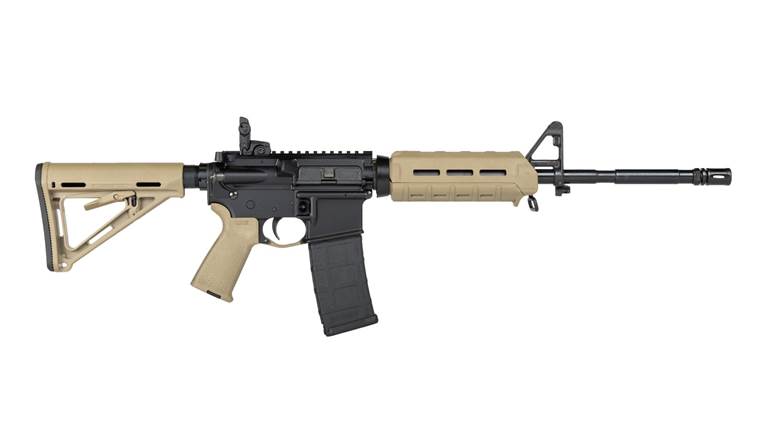
Good ideas are not always complicated ones. With all of the technical advances being made in firearms development, it can be easy to lose sight of the value of a gun that’s simple in its design and operation. For some time now, shooters have enjoyed the rugged, reasonably priced flexibility provided by the Rossi Matched Pair series of long guns. Now those same features can be enjoyed in a Rossi handgun.
The Matched Pair pistol is a side-lever release, break-action, single-shot pistol that arrives with two barrels to use with the pistol frame. One barrel is chambered for .22 Long Rifle, while the other is a combo barrel designed to fire .45 Colt pistol cartridges or .410 shot shells in both 2½- and 3-inch lengths. A removable, straight-rifled choke is provided for use with .410 shot shells, but it must be removed from the barrel to safely fire .45 Colt loads. The two barrels are easily exchanged by loosening the forearm retention screw, removing the forearm and opening the action to lift the barrel off of the frame.
The 11-inch barrels, receiver, hammer, trigger and forearm screw with sling mount are all made of blued steel. The trigger guard, forearm and sight housings are made of polymer. The grip is a hand-filling, finger-grooved synthetic model, which looks similar to the Taurus Raging Bull grips. The adjustable fiber-optic sights (front red, rear green) are the same as those used on the Circuit Judge and Matched Pair long guns. Since no accessory or optic rails are present, this handgun is limited to pistol-sights-only shooting.
The Matched Pair pistol has several safety features, most of which operate unobtrusively in the process of cycling the action. A manual safety switch is located on the left side of the frame. A transfer-bar safety prevents the hammer from contacting the firing pin except when the trigger is fully depressed. A key-operated security lock is located at the base of the hammer. The other safeties become evident when the hammer is in the cocked position, which prevents the action from being either opened or closed until the hammer is moved to the uncocked position. Experienced shooters may not need all of these safety features. but they make sense on a pistol that is likely to be used for training new shooters.
Time on the range showed that, although the Matched Pair pistol's design places much of the weight forward of the grip, it doesn't give the impression of being muzzle heavy when fired with a two-handed shooting stance. Although the hammer is a little heavy to pull back, it's smooth and locks cleanly into the fully cocked position. The single-action trigger of this gun breaks cleanly with 3 pounds, 14 ounces of trigger pull. The recoil-reducing grip and the forward weight of the pistol kept the felt recoil of the .45 Colt and .410 shells to a comfortable level.
I approached the .45 Colt ammunition testing with a bit of trepidation. The .45 Colt/.410 combo revolvers, like the Taurus Judge, usually produce five-shot groups in the 3-inch range at defensive distances of 7 to 10 yards. However, the patterns open up at 25 yards. This loss of tight patterning at greater distances with .45 Colt loads is generally blamed on the long cylinder chamber that the bullet has to travel through before meeting up with the rifling of the barrel. Although the Matched Pair pistol does have the advantages of a fully enclosed chamber, a stretched barrel and no cylinder gap, it still has the long unrifled chamber like the revolvers.
The results of firing five-shot groups from a bench rest into targets set at 25 yards proved to be better than expected. The best single five-shot group of 1.75 inches, and the best average of 2.25 inches, was produced by Winchester Supreme Elite PDX1 225-grain bonded hollow points. DoubleTap 255-grain hard-cast lead semi-wadcutters yielded an average of 2.35 inches, followed by the Hornady Critical Defense 185-grain FTX load at 2.5 inches. All of the loads tested ran flawlessly.
For those who are curious about shooting .410 slug shells from the Matched Pair, or any other .45 Colt/.410 combo gun, save yourself some cash and reserve the slugs for dedicated .410 shotguns. The .410-caliber shotgun slug is traveling down a rifled barrel designed to accommodate .454-caliber .45 Colt bullets. The gaps between the rifling and the smaller .410 slug result in a miserable level of accuracy. A slug from a mixed-caliber handgun will hit the broad side of a barn, but you have to squint and hold your tongue just right to do it. If you have a shooting task that requires a single heavy projectile to accomplish, just remove the choke and enjoy the accuracy the .45 Colt pistol cartridges have to offer.
The .410 shot shell patterns produced by the Matched Pair were excellent in comparison to other .45 Colt/.410 handguns on the market. Quite simply, it trounced the competition. The closed chamber, longer barrel and removable straight-rifled choke produced patterns at 7 yards that rival those produced by 20-inch barreled .410 shotguns. A variety of 2 1/2- and 3-inch birdshot loads produced patterns ranging from 6 to 9 inches. The 00, 000 and No. 4 Buckshot loads tested yielded groups ranging from 2.5 to 5 inches, with the best performance produced by the Federal Premium Handgun 9-Pellet, 3-inch shell.
Two malfunctions occurred during the .410 shotshell shooting set. In both cases, a spent shell lodged in the chamber. They were quickly and easily tapped out with a cleaning rod. Considering the variety of loads tested, the level of fouling in the barrel at the time, the hot nature of the shells fired and the lack of any other kind of malfunction, these two stoppages did not strike me as much to worry about.
It should be noted that the level of felt recoil produced by heavy 3-inch .410 buckshot loads is stout, even with the recoil reducing grips. One shell that is bound to leave a memorable impression on both the shooter and the target is the Winchester PDX1 3-inch Defender load. This shell launches 410-grains of copper-plated lead in the form of four defense disks (pre-flattened buckshot pellets) and 16 BB-size shot pellets at a published handgun velocity of 750 fps. At 7 yards, the defense disks produced a 2.5-inch central group with the BB pellets forming a 6.25-inch pattern around them. I would be handed my walking papers and told to clean out my desk if I ever recommended a single-shot handgun for self-defense. However, it's still good to know that if the Matched Pair were pressed into an emergency defensive roll, it will produce tight, effective buckshot groups with the proper loads.
A five-shot group accuracy test was used to check the .22 Long Rifle barrel. The extractor on this barrel proved to be an ejector. While the .45 Colt/.410 barrel requires spent cases to be removed manually, the .22 barrel spits the spent .22 shells over the shoulder of the shooter. This made reloading that much easier. At 5 yards, this barrel shot to point-of-aim. At 25 yards, it tended to shoot 3- to 4-inches high on the target. This is probably due to the front sight blade resting about 1/4-inch lower on the milled-down barrel than the front sight of the .45 Colt/.410 barrel. Although the sight adjustments I made at the range did not solve the problem, it seems likely a bit of off-the-range tinkering could solve the problem.
While the groups were high, they were tight. A best single group of 1.25 inches was produced by both the Winchester Dynapoint 40-grain copper-plated hollow-point load and the CCI Quiet 40-grain lead round-nose load. The Winchester round produced a best group average of 1.45 inches, followed by the CCI Quiet at 1.65 inches and the Remington 40-Grain lead round-nose load at 1.85 inches. No malfunctions occurred during the formal or informal .22 testing. And as one might expect, the recoil ranged from tame to non-existent with the variety of loads tested.
Sometimes shooting is about gadgets, laser-enhanced optics and lots of rounds fired as rapidly as possible. But on other days, it's about taking that one perfect shot to pot a rabbit for dinner or to give a young shooter the chance know to what it feels like to hit the bullseye. This handgun may not be fancy, but it certainly is rugged, reliable and accurate. It outperforms all of the other .45 Colt/.410 handguns I’ve tested so far. As a short-range hunting pistol, a camp-site gun or as a single-shot plinker, the Rossi Matched Pair pistol offers plenty of flexibility and fun for the price.
Manufacturer: Rossi USA; www.rossiusa.com
Model: Matched Pair Pistol (P4102211BS)
Action: Break-Action Single Shot
Calibers: .45 Colt/.410 & .22 Long Rifle
Finish: Blued
Grips: Rubber
Sights: Adjustable Fiber Optic
Safeties: Manual Thumb Safety, Taurus Security System
Barrel Length: 11”
Overall Length: 16”
Height: 7”
Width: 1.5”
Weight: 5 lbs.
Capacity: 1 Round
.22 Barrel Rifle Twist: 1:16.5” RH
.22 Barrel Rifle Grooves: 12
.45 Colt/.410 Barrel Rifle Twist: 1:16.5” RH
.45 Colt/.410 Barrel Rifle Grooves: 6
Accessories: Removable Choke Tube, Choke Wrench, Security Keys
Suggested Retail Price: $357






































